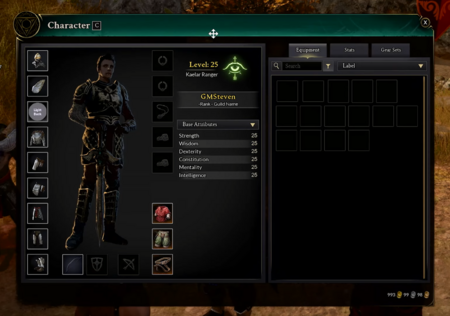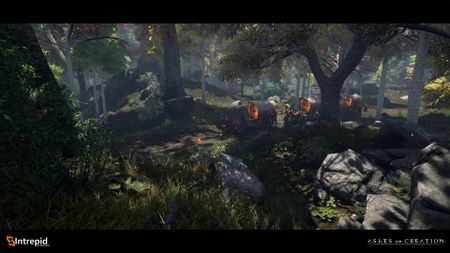Artisan progression
| Artisan level | Artisan certification | Profession limit per character |
|---|---|---|
| 1-10.[4][5] | Novice.[1][6] | 22.[1][2] |
| 10-20.[7][5] | Apprentice.[1] | 5.[1][2] |
| 20-30.[7] | Journeyman.[1][3] | 4.[1][2] |
| 30-40.[7] | Master.[1][3] | 3.[1][2] |
| 40-50.[7][8] | Grandmaster.[1][3] | 2.[1][9][2] |
Artisan progression occurs based on experience (repetition of tasks) as well as achievements of certain benchmarks within each artisan branch (Gathering, Processing and Crafting).[11] Progression in each artisan profession is per-character.[12][13][14][15]
- All 22 professions, the players get to be novice of; and then it starts narrowing from there. So, after that you'll only be able to be apprentice of five things. You can be a journeyman in four things. You can be a master in three things; and you can be a grandmaster in two things. So you'll need to narrow, but you can also diversify to support the professions that you want to first push further in.[2] – Kory Rice
- Progression to each "tier" within a profession grants skill points that can be utilized in a character's artisan skill tree.[17]
- Artisan certification quests must be completed to gain proficiency in that tier of artisan progression.[18] Completing certification unlocks benefits for that profession, such as artisan tools for gathering professions and recipes for crafting professions.[19][20]
- There are limits to the number of professions at each certification tier across the three artisan branches.[1][9][21][2][22] For example: a character may only ever be a Master in up to 3 professions and Grandmaster in up to 2 professions across all artisan branches.[1][9]
- Grandmaster artisans can max out their entire profession skill tree, but a character can only be a grandmaster of up to two professions.[23]
- Achieving an artisan certification in a profession also implies that the character also achieved any lower-tier certifications up to that point.[24]
- If you are grand master in that profession you can max out the entire tree. But you can only grand master 2 things.[23] – Kory Rice
- Choosing a specific path in the skill tree allows the player an opportunity to specialize in a certain area. This encourages player inter-dependency, enhancing the artisan experience.[25]
- Progression within artisan classes does not directly relate to progression in a character's adventuring class, but there are requirements that take into account dangers, locations, toolsets, and surveying options that are dependent on adventuring level.[26][27][28]
- Characters gain XP as they progress their professions.[29][20]
- It should be expected that some artisans will have significantly higher artisan level than their adventuring level.[29][26]
- Q: In regards to character level and artisan level. We know that currently there are two separate things. That being said, what prevents a player from staying level one and partying up with a level 50 player to then gather level 50 resources in the high zones? That way, anyone who wants to take those resources will have to kill the gatherer who is level one and get a large amount of corruption for killing a level one as a level 50.
- A: Gathering higher level resources requires significant advancement within a particular profession for that gatherable resource. So, if I'm a Miner and I want to access the highest possible mineral, I need to be a master miner; and in order to achieve the master minor status I am going to be gaining adventuring level experience through that process, because many of those quest lines, many of those achievements are facilitated through quest lines. Some of those quest lines interface with adventuring difficulties that are out in the wild at certain levels. So that's going to predicate me- that's going to be a predicate for me to achieve a certain level in order to complete some of these quest lines and achieve that master status. So you will you will likely not see the ability of a level one alt character having the access to high level mineral mining, or any other type of gatherable out there.[26] – Steven Sharif
Artisan skill tree
Progression to each "tier" within an artisan profession grants skill points that can be utilized in a character's artisan skill tree.[17]
- In all three of the branches you'll have skill trees for your profession. So, those skill trees you'll be able to find passives that'll give you stat bonuses, and predicates for extra functionality within whatever the profession is, access to stations, expanding out some of the various systems, like you can see some of the surveying ones: You can add extra pylons, or extra scanning range, and lower the cooldown on how often you can survey. So, we're trying to make those trees interesting and give people know different paths so they can progress through.[10] – Kory Rice
- Respeccing artisan skills is going to be more difficult than respeccing adventuring skills.[30]
Artisan certification quests
Artisan progression within each profession requires the completion of certification quests.[18]
- We're planning on having some content related to onboarding players to the different professions; and you're going to need a tool for the first time; and you're going to want to craft a thing for the first time; and learn how to do those things. But, we also want to extend that out to more of a individual story-arc-like experience for players. So, as you as you become a better Lumberjack you'll play out your story as as a lumberjack: so these different certification quests are to be keystone moments in that story progression.[18] – Kory Rice
- There are limits to the number of professions at each certification tier across the three artisan branches.[1][9][21][22]
- Achieving an artisan certification in a profession also implies that the character also achieved any lower-tier certifications up to that point.[24]
List of artisan certification quests
| Quest | Location | Quest giver | Steps | XP | Currency |
|---|---|---|---|---|---|
| We Rise after Felling | Woodshops | Master Woodcutter | 1 | 0 |
Artisan mastery
A character may only ever be a Master in up to 3 professions and Grandmaster in up to 2 professions across all artisan branches.[1][9]
- Artisan mastery is no longer restricted to a single branch.[9]
- Characters may change which professions they master.[31]
- Becoming a master Crafter or a master Processor or a master Gatherer should be a significant time investment and resource investment; and because of that it should also be something that when you achieve that status it's like people on the server know who you are.[32] – Steven Sharif
- Masteries aren’t just about making an item. They grant many things, including titles, access to items, bargains, and quests. [33]
- Previously it was stated that with considerable effort a player can master all professions within a mastered parent artisan class.[34][35] This was later changed to a player being able to master some but not all professions within a mastered parent artisan class.[36][37] This was changed to being able to master up to two or three professions within a mastered parent artisan class (subject to testing).[13] This was changed to being able to master up to two professions.[12] The current stance is only being able to become a Master of 3 professions and Grandmaster of 2 professions across all branches.[1][9]
- Q: What would be the daily activities for someone at level 50 with a maxed out artisan tree?
- A: The daily activity might be something along the lines of, depending on what type of profession or processor you are, of interacting with fellow artisanship individuals to wheel and deal on supply and demand chains; orchestrating and participating and caravan roads that move materials across the world so that you can satisfy buy orders and/or commission requests. Participating in unique trades and/or dungeon experiences that have the opportunity to acquire unique crafting materials so that you can create the dragon's legendary sword and sell that potentially. Finding unique harvestable materials in remote parts of the world or engaging in treasure map finding for again unique materials and/or processing things. There's a whole host of different intents that are loops for the players to participate in that again are situationally relevant based on the world state.[38] – Steven Sharif
Artisan gear

There's gear for all of the different crafting, gathering, and processing professions that'll help you do those different trades.[40] – Kory Rice
Artisan gear boosts artisans in their gathering, processing, or crafting professions.[40][41][42]
- Profession NPCs sell lower level artisan gear.[43] Higher level gear is crafted by players.[41]
- There are three artisan gear slots on a character's paper doll UI.[39] Previously these was referred to as undergarment slots.[41]
- Artisan gear and adventuring gear do not need to be swapped for either to be effective when they are equipped on a character, but players will be able to toggle gear visibility between their adventuring and artisan gear.[44][39][41]
- If you want to be seen as wearing the herbalists outfit, you're still going to have your adventuring gear present and on the character, and benefiting from the stats that are conferred by them; and vice-versa.[44] – Steven Sharif
- Gathering tools and artisan gear have stats that affect gathering rates and yields.[45][46]
- Gear for artisans are going to live alongside your adventuring gear. So you will currently- the approaches, and we'll test this but currently- the approach is you'll have artisanship oriented gear. This might be beneficial for your gathering; it might be beneficial for your processing, or crafting, or whatever it is- your profession. Essentially you will craft that gear, you will equip that gear, it'll live almost as a undergarment slot so to speak; and then you can activate that and it will show the appearance if you wish during the activation when you gain the benefit from the from the gear itself; and then could disappear afterwards and go back to your adventuring gear. That's the current approach. We're going to play with that a little bit. There's some discussion and disagreement on the team about how we do that, but our hopes are for Alpha two, we will have I think a couple of sets at least. We're demonstrating all of the artisanship from gathering to processing to crafting in limited fashion in Alpha 2 want to have that gear present to play with this approach.[41] – Steven Sharif
Gathering tools

Different professions will have a number of quests available to introduce players to their first toolsets; and then, their toolset sustainability will be incumbent on the player to continue to gather the resources necessary to repeatedly create these tools, because they have a durability that gets expended when interacting with the resources in the open-world.[48] – Steven Sharif
Each gathering profession will have three tools. The tools come online as you progress through the profession; and the different resource types for each one of the professions may require different tools. So, you basically want to carry around the right tool for the job. And tools along with artisanship gear will have stats on it, so you can itemize towards how you want to gather, how fast you want to gather.[45] – Kory Rice
Gathering tools (also referred to as harvesting tools, artisan tools, and toolsets) enable the gathering of resources in Ashes of Creation.[45][49][50][51]
- Each gathering profession has three gathering tools. Each tool allows gathering of different resource types.[45]
- Gatherers must meet the required artisan certification to utilize tools of that level (or lower).[53]
- Gathering tools are equipped to a character's artisan tool slot.[5]
- Progression in the gathering artisan class unlocks higher level harvesting tools that enable gathering of higher level resources.[45][54][55]
- Artisan progression unlocks higher level surveying tools that enable better identification of gatherable resources within a location.[55]
- Higher level of progression can also speed up gathering times, resource yields, and may allow access to resources at earlier growth stages.[52][46]
- A gatherer at maximum proficiency will unlock master toolsets that will grant them access to the highest quality gatherables.[56]
- Tools do advance within the artisan tree, so your ability to either gather, process or craft will require the equivalent tools necessary at that stage of crafting in order to accomplish the task at hand. So, you could not mine copper and mithril with the same tool.[51] – Steven Sharif
- Tools will have durability and lifespans.[48][56][57]
- Artisans will not need to rely on other trees in order to make their tools.[50]
- The developers are considering the introduction of gathering tools that require two players, such as two-person saws that can fell larger trees.[54]
- Your progression within the profession will take account what tools you can use. There might even be some opportunity to do some gathering with other players that . Typically in other games that I play you usually do the gathering alone. You're venturing around alone; and we wanted to take a look at maybe having a friend to help you with a two person saw on a larger tree. Maybe there's some panning that you could do as opposed to just hitting with the pickaxe. So, we'll have other tools that are part of that progression path and other activities that players can do if they would like to gather together.[51] – Kory Rice
Artisan supply chain
Artisans within Ashes of Creation must choose a path in their artisan skill tree. This inter-dependency establishes a supply chain from raw materials to finished product.[58][59] Each stage of the chain may require caravans to transport goods from one artisan to another.[25]
- Obtaining raw materials:[60]
- Refining the raw materials with the Processing profession.[59]
- Crafting the finished product using its crafting recipe.[59]
As a crafter you're going to want to know where certain recipes can be fulfilled; which nodes have the capability of creating what you've processed material that you've gathered for; and then you're going to want to plan out your route to either transit the goods there or make sure that you're situated in the area so that you can go out collect and build in that area as well. So there's a lot of planning that's going to be necessary.[63] – Steven Sharif
See also
References
- ↑ 1.00 1.01 1.02 1.03 1.04 1.05 1.06 1.07 1.08 1.09 1.10 1.11 1.12 1.13 1.14 1.15 1.16

- ↑ 2.0 2.1 2.2 2.3 2.4 2.5 2.6 2.7 2.8 2.9 Video, November 30, 2023 (37:12).
- ↑ 3.0 3.1 3.2 3.3 Development Update with Freehold Preview.
- ↑

- ↑ 5.0 5.1 5.2 Video, November 30, 2023 (9:36).
- ↑ Livestream, June 30, 2023 (50:07).
- ↑ 7.0 7.1 7.2 7.3 Podcast, December 3, 2023 (14:14).
- ↑ Podcast, December 3, 2023 (2:53).
- ↑ 9.0 9.1 9.2 9.3 9.4 9.5 9.6

- ↑ 10.0 10.1 10.2 Video, November 30, 2023 (23:20).
- ↑ Interview, February 7, 2021 (36:38).
- ↑ 12.0 12.1

- ↑ 13.0 13.1 Livestream, April 29, 2022 (1:13:00).
- ↑ Livestream, July 26, 2019 (1:09:46).
- ↑ Livestream, May 24, 2017 (32:07).
- ↑ Podcast, December 3, 2023 (10:22).
- ↑ 17.0 17.1 Video, November 30, 2023 (26:38).
- ↑ 18.0 18.1 18.2 18.3 Video, November 30, 2023 (16:40).
- ↑ Podcast, December 3, 2023 (17:10).
- ↑ 20.0 20.1 Video, November 30, 2023 (36:00).
- ↑ 21.0 21.1

- ↑ 22.0 22.1

- ↑ 23.0 23.1 Podcast, December 3, 2023 (6:23).
- ↑ 24.0 24.1

- ↑ 25.0 25.1 Livestream, May 10, 2017 (6:12).
- ↑ 26.0 26.1 26.2 Livestream, April 7, 2023 (1:00:55).
- ↑ Livestream, October 28, 2022 (1:32:38).
- ↑ Livestream, July 31, 2020 (1:31:11).
- ↑ 29.0 29.1 Podcast, December 3, 2023 (15:05).
- ↑ Livestream, December 19, 2023 (1:46:12).
- ↑

- ↑ Interview, July 20, 2020 (18:47).
- ↑

- ↑

- ↑

- ↑

- ↑

- ↑ Interview, July 9, 2023 (42:51).
- ↑ 39.0 39.1 39.2 Video, November 30, 2023 (19:06).
- ↑ 40.0 40.1 Video, November 30, 2023 (5:47).
- ↑ 41.0 41.1 41.2 41.3 41.4 41.5 Livestream, June 30, 2022 (1:17:34).
- ↑ Livestream, March 26, 2021 (1:06:50).
- ↑ Video, November 30, 2023 (12:05).
- ↑ 44.0 44.1 Livestream, November 30, 2023 (1:37:49).
- ↑ 45.0 45.1 45.2 45.3 45.4 45.5 45.6 Video, June 30, 2023 (3:14).
- ↑ 46.0 46.1 46.2 Video, October 28, 2022 (26:14).
- ↑ Video, November 30, 2023 (7:56).
- ↑ 48.0 48.1 48.2 48.3 Video, November 30, 2023 (5:58).
- ↑ Livestream, October 14, 2022 (32:38).
- ↑ 50.0 50.1 Interview, March 27, 2020 (9:00).
- ↑ 51.0 51.1 51.2 Interview, May 11, 2018 (38:25).
- ↑ 52.0 52.1 Livestream, December 19, 2023 (1:53:02).
- ↑ Podcast, December 3, 2023 (12:27).
- ↑ 54.0 54.1 Video, October 28, 2022 (25:11).
- ↑ 55.0 55.1 Livestream, April 30, 2020 (53:11).
- ↑ 56.0 56.1 56.2 Livestream, July 31, 2020 (1:05:58).
- ↑ 57.0 57.1

- ↑ Interview, July 20, 2020 (20:17).
- ↑ 59.0 59.1 59.2 59.3 Livestream, May 10, 2017 (8:22).
- ↑ 60.0 60.1 60.2 60.3 60.4 Livestream, May 8, 2017 (20:41).
- ↑ Livestream, July 18, 2017 (38:30).
- ↑ Livestream, May 26, 2017 (26:00).
- ↑ Interview, May 11, 2018 (24:18).

